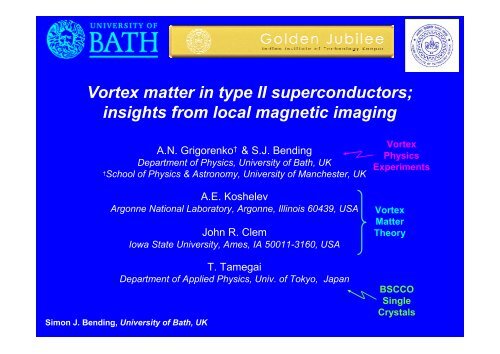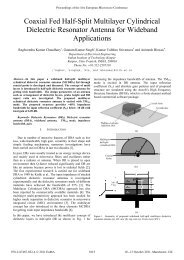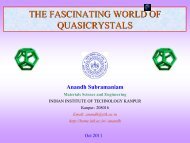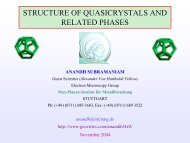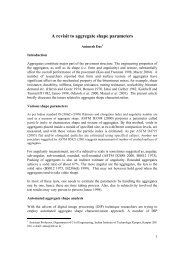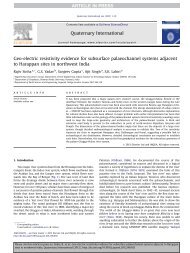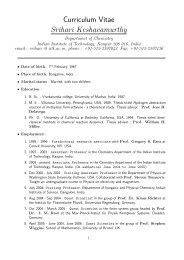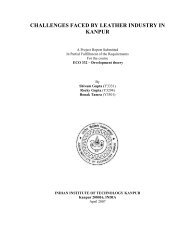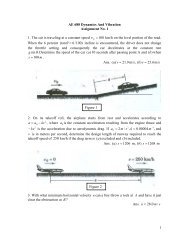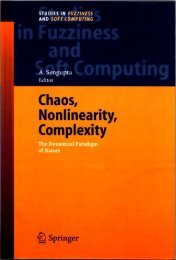Vortex matter in type II superconductors; insights from ... - iitk.ac.in
Vortex matter in type II superconductors; insights from ... - iitk.ac.in
Vortex matter in type II superconductors; insights from ... - iitk.ac.in
Create successful ePaper yourself
Turn your PDF publications into a flip-book with our unique Google optimized e-Paper software.
<strong>Vortex</strong> <strong>matter</strong> <strong>in</strong> <strong>type</strong> <strong>II</strong> <strong>superconductors</strong>;<br />
<strong>in</strong>sights <strong>from</strong> local magnetic imag<strong>in</strong>g<br />
A.N. Grigorenko † & S.J. Bend<strong>in</strong>g<br />
Department of Physics, University of Bath, UK<br />
†School of Physics & Astronomy, University of Manchester, UK<br />
A.E. Koshelev<br />
Argonne National Laboratory, Argonne, Ill<strong>in</strong>ois 60439, USA<br />
Simon J. Bend<strong>in</strong>g, University of Bath, UK<br />
John R. Clem<br />
Iowa State University, Ames, IA 50011-3160, USA<br />
T. Tamegai<br />
Department of Applied Physics, Univ. of Tokyo, Japan<br />
<strong>Vortex</strong><br />
Physics<br />
Experiments<br />
<strong>Vortex</strong><br />
Matter<br />
Theory<br />
BSCCO<br />
S<strong>in</strong>gle<br />
Crystals
Introduction<br />
Type <strong>II</strong> <strong>superconductors</strong> & vortex <strong>matter</strong><br />
The vortex <strong>matter</strong> phase diagram <strong>in</strong> Bi 2 Sr 2 CaCu 2 O 8+δ<br />
‘Cross<strong>in</strong>g’ vortex lattices <strong>in</strong> layered <strong>superconductors</strong><br />
Scann<strong>in</strong>g Hall probe magnetic imag<strong>in</strong>g<br />
Experimental Results; <strong>Vortex</strong> <strong>matter</strong> <strong>in</strong> Bi 2 Sr 2 CaCu 2 O 8+δ<br />
First order melt<strong>in</strong>g of the vortex lattice, H = H z<br />
– The <strong>in</strong>fluence of quenched disorder<br />
‘Decoration’ of Josephson vortices by pancake vortices<br />
<strong>Vortex</strong> lattice melt<strong>in</strong>g <strong>in</strong> the presence of an <strong>in</strong>-plane magnetic field<br />
Indirect p<strong>in</strong>n<strong>in</strong>g and vortex st<strong>ac</strong>k fragmentation<br />
Conclusions and Prospects<br />
Simon J. Bend<strong>in</strong>g, University of Bath, UK<br />
OUTLINE
Introduction to Type <strong>II</strong> Superconductors<br />
In 1954 Abrikosov solved the G<strong>in</strong>zburg-Landau equations <strong>in</strong> an applied magnetic<br />
λ 1<br />
field for κ = > . He found his famous vortex solution whereby ψ(x,y) conta<strong>in</strong>s a<br />
ξ 2<br />
periodic lattice of zeroes.<br />
Abrikosov – 2003<br />
Physics Nobel Prize<br />
Meissner<br />
Simon J. Bend<strong>in</strong>g, University of Bath, UK<br />
Φ ο<br />
Mixed phase<br />
B<br />
E<strong>ac</strong>h ‘normal’ pole is associated with a<br />
circulat<strong>in</strong>g supercurrent that generates<br />
a s<strong>in</strong>gle quantum of magnetic flux, φ 0.<br />
Leads to a new mixed Abrikosov<br />
vortex phase between the Meissner<br />
and normal states.
Bi 2 Sr 2 CaCu 2 O 8+δ<br />
Introduction to <strong>Vortex</strong> Matter<br />
U(r i j)<br />
i j<br />
Vortices are mutually repulsive - leads to<br />
formation of an ordered triangular lattice.<br />
VORTEX MATTER: Elastic moduli of lattice are small and the mixed state represents a form of<br />
soft l<strong>in</strong>e-like <strong>matter</strong> that exhibits phases and phase transitions (e.g., melt<strong>in</strong>g) <strong>in</strong> which thermal<br />
fluctuations and disorder play key roles.<br />
- can tune vortex density and <strong>in</strong>ter<strong>ac</strong>tion strengths by many orders of magnitude by vary<strong>in</strong>g H z<br />
A model system for <strong>in</strong>vestigat<strong>in</strong>g structural phase transitions.<br />
Discovery of high T c cuprates led to renewed <strong>in</strong>terest <strong>in</strong> vortex <strong>matter</strong>:-<br />
– high operation temperatures lead to much higher thermal energies (kT)<br />
1<br />
– high crystall<strong>in</strong>e anisotropy moves phase transition l<strong>in</strong>es further <strong>from</strong> H B c2 m ~ 2<br />
γ<br />
Simon J. Bend<strong>in</strong>g, University of Bath, UK<br />
r i j<br />
2<br />
φ ⎛ r<br />
0<br />
ij ⎞<br />
U( rij<br />
) ~ exp ⎜<br />
⎜−<br />
⎟<br />
2<br />
2πµ<br />
0λ<br />
⎝ λ ⎠<br />
Vortices readily <strong>in</strong>ter<strong>ac</strong>t with quenched<br />
disorder, becom<strong>in</strong>g p<strong>in</strong>ned on e.g.,<br />
defects and impurities <strong>in</strong> the sample.<br />
γ = anisotropy parameter
Pancake Vortices <strong>in</strong> Bi 2Sr 2CaCu 2O 8+δ - H=H z<br />
Bi Bi2Sr 2Sr2CaCu 2CaCu2O 2O8+δ 8+δ<br />
The layered structure and very strong crystall<strong>in</strong>e anisotropy <strong>in</strong> the<br />
cuprate superconductor Bi 2Sr 2CaCu 2O 8+δ (BSCCO) gives rise to<br />
pancake vortices with the applied field along the high symmetry c-axis.<br />
- supercurrents flow predom<strong>in</strong>antly <strong>in</strong> the CuO 2 layers which are only<br />
weakly coupled along the c-axis direction.<br />
Simon J. Bend<strong>in</strong>g, University of Bath, UK<br />
(a)<br />
CuO 2 plane<br />
c^<br />
H<br />
^<br />
b<br />
a^<br />
pancake<br />
vortex
Pancake <strong>Vortex</strong> Phase Diagram – Bi 2Sr 2CaCu 2O 8+δ<br />
H (Oe)<br />
10 5<br />
10 4<br />
10 3<br />
10 2<br />
10 1<br />
Highly<br />
disordered<br />
glass<br />
Bragg glass<br />
Simon J. Bend<strong>in</strong>g, University of Bath, UK<br />
Liquid / Gas<br />
Thermally driven<br />
H c2<br />
0 20 40<br />
T (K)<br />
60 80 100<br />
Meissner state, H c1<br />
Thermally driven<br />
Scann<strong>in</strong>g Tunnell<strong>in</strong>g Microscopy<br />
Disorder driven<br />
<strong>Vortex</strong><br />
crystal (?)<br />
Scann<strong>in</strong>g Hall Probe Microscopy<br />
Re-entrant liquid<br />
Adapted <strong>from</strong> a phase diagram due to Eli Zeldov.
Phase Transition L<strong>in</strong>es – Bi 2Sr 2CaCu 2O 8+δ<br />
Khaykovich et al., Phys.<br />
Rev. Lett 76, 2555<br />
(1996)<br />
Second<br />
magnetisation<br />
peak<br />
E couple ~ E p<strong>in</strong><br />
Bragg glass<br />
Po<strong>in</strong>t-like disorder<br />
too weak to create<br />
dislocations but<br />
destroys true long<br />
range order.<br />
Giamarchi et al.,<br />
PRB 52, 1242 (1995)<br />
B (G)<br />
10 5<br />
10 5<br />
10 5<br />
10 4<br />
10 4<br />
10 4<br />
10 3<br />
10 3<br />
10 3<br />
10 2<br />
10 2<br />
10 2<br />
10 1<br />
10 1<br />
10 1<br />
Highly<br />
disordered<br />
glass<br />
Simon J. Bend<strong>in</strong>g, University of Bath, UK<br />
Disorder Disorder driven driven<br />
Bragg glass<br />
Dep<strong>in</strong>n<strong>in</strong>g transition -<br />
Glass transition l<strong>in</strong>e?<br />
Thermally Thermally driven driven<br />
E p<strong>in</strong> ~ E th<br />
Liquid / Gas<br />
Thermally Thermally driven driven<br />
<strong>Vortex</strong><br />
crystal (?)<br />
H c2<br />
0 20 40 60 80 100<br />
Meissner state, H c1<br />
T (K) Re-entrant liquid<br />
Energy scales:<br />
Ecouple – J & EM coupl<strong>in</strong>g<br />
Eel – Elastic energy<br />
Ep<strong>in</strong> – P<strong>in</strong>n<strong>in</strong>g potential<br />
Eth – Thermal energy<br />
Zeldov et al.,Nature<br />
375, 373 (1995)<br />
First order<br />
melt<strong>in</strong>g<br />
E el ~E th
B<br />
Sample<br />
Scan<br />
Voltages<br />
Scanner<br />
Tube<br />
Tilt<br />
Stage<br />
Electronics<br />
STM Tip<br />
Bias<br />
1-2 o<br />
Hall<br />
Probe<br />
Simon J. Bend<strong>in</strong>g, University of Bath, UK<br />
Scann<strong>in</strong>g Hall Probe Imag<strong>in</strong>g<br />
Z(x,y)<br />
B z(x,y)<br />
PC<br />
Hall<br />
Voltage<br />
I Hall<br />
V + Hall<br />
I -<br />
V - Hall<br />
I +<br />
Hall<br />
sensor<br />
2µm<br />
STM<br />
tip<br />
(I tip )<br />
+<br />
+<br />
+<br />
+<br />
E c<br />
10nm GaAs<br />
80nm n-AlGaAs<br />
electrons<br />
1000nm GaAs<br />
~100nm Hall probe wet etched <strong>in</strong><br />
a GaAs/AlGaAs heterostructure.<br />
-20 -10 0 10 20<br />
H (Oe)<br />
Sensor can be moved to any location and<br />
a ‘local’ magnetisation curve generated.<br />
M l (G)<br />
2<br />
0<br />
-2
First Order <strong>Vortex</strong> Lattice Melt<strong>in</strong>g - H = H z<br />
Zeldov et al. (Nature 375, 373 (1995)) first unambiguously identified vortex lattice<br />
melt<strong>in</strong>g <strong>in</strong> Bi 2Sr 2CaCu 2O 8+δ s<strong>in</strong>gle crystals us<strong>in</strong>g local Hall probe measurements.<br />
- vortex density (≡ B) <strong>in</strong>creases slightly when system melts (like water).<br />
M z (a.u.)<br />
10<br />
5<br />
0<br />
-5<br />
T= 85K<br />
-10<br />
-15 -10 -5 0<br />
Hz (Oe)<br />
5 10 15<br />
There is no proper theory of vortex melt<strong>in</strong>g and<br />
nearly all theoretical works are based on the<br />
L<strong>in</strong>demann criterion, i.e., melt<strong>in</strong>g occurs when<br />
1/2 = C L ×a,<br />
where C L ~ 0.2 is the L<strong>in</strong>demann constant.<br />
Simon J. Bend<strong>in</strong>g, University of Bath, UK<br />
H m<br />
∆M~0.5G<br />
H m H m<br />
B m (G)<br />
50<br />
40<br />
30<br />
20<br />
10<br />
Bragg<br />
Glass<br />
Cut along a<br />
l<strong>in</strong>e at T=81K<br />
0<br />
76 78 80 82 84 86 88<br />
T (K)<br />
Liquid<br />
1/2<br />
a
First Order <strong>Vortex</strong> Lattice Melt<strong>in</strong>g - H = H z<br />
Image 1 Image 2 Image 3<br />
The vortex system must be left to<br />
equilibrate for several tens of m<strong>in</strong>utes.<br />
- v<strong>ac</strong>ancies and shear waves<br />
frequently observed <strong>in</strong> rapid imag<strong>in</strong>g.<br />
Simon J. Bend<strong>in</strong>g, University of Bath, UK<br />
Oral et al., Phys. Rev. Lett. 80, 3610 (1998)<br />
H z = 10Oe<br />
T = 81K
First Order <strong>Vortex</strong> Lattice Melt<strong>in</strong>g - H = H z<br />
10 Oe 12 Oe 14 Oe 16 Oe 18 Oe 20 Oe 22 Oe<br />
L<strong>in</strong>escans are generated <strong>ac</strong>ross cha<strong>in</strong>s of<br />
vortices at e<strong>ac</strong>h magnetic field and fitted to<br />
a pancake model due to John Clem.<br />
Allows extr<strong>ac</strong>tion of vortex fluctuation<br />
amplitude quantified by the parameter σ.<br />
B ( r, h)<br />
=<br />
z<br />
0<br />
2 2<br />
// a<br />
σ = standard deviation of lateral fluctuations.<br />
J. R. Clem, Physica C 235-240, 2607 (1994) & (unpublished).<br />
Simon J. Bend<strong>in</strong>g, University of Bath, UK<br />
2<br />
2<br />
j<br />
σ G<br />
Q j z −<br />
<br />
− ∆ i 2<br />
− G j h iG j . r<br />
∞ 2sφ<br />
e e e e<br />
3λ<br />
Q = G + 1 λ<br />
2 2<br />
j j //<br />
∑∑<br />
( Q + G )<br />
i= 0 j j j<br />
G j = reciprocal vortex lattice vector.<br />
∆∆∆∆z i = i.s - summed over consecutive CuO 2 planes<br />
h = height of sensor above surf<strong>ac</strong>e<br />
∆B (G)<br />
0.6<br />
0.4<br />
0.2<br />
0.0<br />
-0.2<br />
H z = 14Oe<br />
T=81K<br />
H m<br />
23 Oe<br />
-0.4<br />
-1 0 1 2<br />
x (µm)<br />
3 4 5<br />
c.f., Oral et al., Phys. Rev. Lett. 80, 3610 (1998)
∆B<br />
First Order <strong>Vortex</strong> Lattice Melt<strong>in</strong>g H = H z<br />
1/2 /a grows aga<strong>in</strong><br />
at low fields<br />
– possible signature<br />
of re-entrant melt<strong>in</strong>g?<br />
a<br />
∆∆∆∆B (G)<br />
0.8<br />
0.6<br />
0.4<br />
0.2<br />
Simon J. Bend<strong>in</strong>g, University of Bath, UK<br />
13.355<br />
0<br />
T=81K<br />
Estimated fluctuation<br />
amplitude exhibits abrupt<br />
jump at H m.<br />
1/2 /a(H m) = C L ~ 0.26.<br />
C L ~ 0.26<br />
H m<br />
0.4<br />
0.3<br />
0.2<br />
0.1<br />
0.0<br />
0.0<br />
0 5 10 15<br />
Heff (Oe)<br />
20 25<br />
A s<strong>in</strong>gle sharp<br />
transition is observed<br />
- probable that vortex<br />
l<strong>in</strong>es simultaneously<br />
melt and decouple.<br />
1/2 /a<br />
c.f., Oral et al., Phys. Rev. Lett. 80, 3610 (1998)<br />
1/2<br />
a
Influence of Disorder on First Order Melt<strong>in</strong>g<br />
Local magnetisation tr<strong>ac</strong>es at 3 different<br />
locations on a BSCCO crystal at 82K <strong>in</strong> the<br />
locations <strong>in</strong>dicated on the image (H z =38Oe).<br />
Oral et al., Phys. Rev. B 56, 14295 (1997)<br />
Simon J. Bend<strong>in</strong>g, University of Bath, UK<br />
Po<strong>in</strong>t disorder and anisotropy are known to shift H m.<br />
Local variations <strong>in</strong> these parameters, quenched<br />
dur<strong>in</strong>g crystal growth, lead to roughen<strong>in</strong>g of the<br />
H m (x,y) landscape.<br />
H z =-12.8Oe H z =-11.2Oe<br />
=<br />
–<br />
Difference image<br />
T=85K<br />
Liquid<br />
SHPM<br />
Solid<br />
MOI<br />
MO difference image; H a =83Oe,<br />
dH a =0.5Oe, T=70K.<br />
(0.26mm x 0.34mm)<br />
Zeldov et al., Nature 406, 282 (2000)<br />
Pl<strong>ac</strong><strong>in</strong>g upper bounds on the superheat<strong>in</strong>g field<br />
yields estimate of S/L surf<strong>ac</strong>e tension which is<br />
more than 100x lower than theoretical estimates.<br />
Melt<strong>in</strong>g completely dom<strong>in</strong>ated by disorder!
Anisotropic <strong>Vortex</strong> Structures <strong>in</strong> Bi 2Sr 2CaCu 2O 8+δ – Arbitrary H<br />
Bi Bi2Sr 2Sr2CaCu 2CaCu2O 2O 8+δ<br />
Simon J. Bend<strong>in</strong>g, University of Bath, UK<br />
(a) (b)<br />
CuO 2 plane<br />
c^<br />
H<br />
^<br />
b<br />
a^<br />
pancake<br />
vortex<br />
Very strong crystall<strong>in</strong>e anisotropy <strong>in</strong> the cuprate<br />
superconductor Bi 2Sr 2CaCu 2O 8+δ (BSCCO) is also<br />
reflected <strong>in</strong> the vortex (and vortex lattice)<br />
structure as a function of direction of applied field.<br />
H<br />
Josephson<br />
vortex<br />
c^<br />
^<br />
b<br />
^a<br />
rhombic unit cell<br />
Realistic side view of<br />
Josephson vortex lattice.
Tilted <strong>Vortex</strong> Instability <strong>in</strong> Bi 2Sr 2CaCu 2O 8+δ S<strong>in</strong>gle Crystals<br />
Josephson<br />
vortex<br />
segment<br />
pancake<br />
vortex<br />
Tilted <strong>Vortex</strong><br />
H<br />
d = 0.866 γ. Φo<br />
/B//<br />
d = Φo<br />
/ 0.866.Bz<br />
JVs <strong>from</strong> side<br />
A homogeneous tilt of the PV st<strong>ac</strong>ks costs<br />
magnetic energy and for a wide range of applied<br />
field angles the ground state consists of coexist<strong>in</strong>g,<br />
perpendicular JV and PV ‘cross<strong>in</strong>g lattices’.<br />
L.N.Bulaevskii et al., PRB 46, 366 (1992)<br />
Simon J. Bend<strong>in</strong>g, University of Bath, UK<br />
PVs <strong>from</strong><br />
top<br />
H<br />
Cross<strong>in</strong>g Lattices<br />
Inter<strong>ac</strong>tions between JV and PV Lattices<br />
CuO 2<br />
planes<br />
JV<br />
j n<br />
PV<br />
PVs ly<strong>in</strong>g on st<strong>ac</strong>ks of JVs become<br />
displ<strong>ac</strong>ed (u n) due to <strong>in</strong>ter<strong>ac</strong>tions<br />
with the JV supercurrents.<br />
2<br />
E = AC . u − B. j u<br />
n 44 n n n<br />
Although this costs the st<strong>ac</strong>k tilt<br />
energy it results <strong>in</strong> a net reduction<br />
of energy, and leads to an attr<strong>ac</strong>tive<br />
<strong>in</strong>ter<strong>ac</strong>tion between JVs and PVs.<br />
j -n<br />
A.E.Koshelev, PRL 83, 187 (1999).
‘Decoration’ of Josephson Vortices by Pancake Vortices<br />
magnetic<br />
particles<br />
Bitter decoration<br />
Simon J. Bend<strong>in</strong>g, University of Bath, UK<br />
‘Decoration’ with pancake vortices<br />
pancake<br />
vortices<br />
Only pancake vortices at the surf<strong>ac</strong>e<br />
are visible <strong>in</strong> our experiments.
‘Decoration’ of Josephson Vortices by Pancake Vortices<br />
12.5µm<br />
θ=0 o θ=66 o<br />
H //<br />
Simon J. Bend<strong>in</strong>g, University of Bath, UK<br />
also seen <strong>in</strong> Bitter decoration †<br />
H z=12Oe, H //=0Oe T=81K H z=14Oe, H //=32Oe, T=81K H z=10Oe, H //=32Oe, T=77K<br />
25µm<br />
H //<br />
θ=73 o<br />
θ=86 o θ=89 o θ=89 o<br />
H // H // H //<br />
H z=2Oe, H //=27Oe,T=81K H z=0.5Oe, H //=38Oe, T=81K H z89 o<br />
1D cha<strong>in</strong>s of PV st<strong>ac</strong>ks<br />
(Grayscale spans ~ 4G)<br />
† C.A.Bolle et al., PRL 66, 112 (1991)<br />
I.V.Grigorieva et al., PRB 51, 3765 (1995).<br />
c<br />
θ<br />
H //<br />
H<br />
H z<br />
a,b<br />
Segments of fragmented<br />
PV st<strong>ac</strong>ks? (Sublimation?<br />
Re-entrant tilted state?)<br />
(Grayscale spans ~ 0.4G)<br />
H
Schematic H z – H x <strong>Vortex</strong> Matter Phase Diagram<br />
Proposed experimental phase<br />
diagram for the different<br />
observed states of vortex <strong>matter</strong><br />
<strong>in</strong> the H<br />
- H // doma<strong>in</strong> for the<br />
c<br />
temperature range where this<br />
study was performed (77-88K).<br />
Simon J. Bend<strong>in</strong>g, University of Bath, UK<br />
10<br />
1<br />
0.1<br />
0.01<br />
Log(H (Oe))<br />
c<br />
H c1<br />
<strong>II</strong>. Tilted<br />
Lattice<br />
I. Meissner<br />
state<br />
V<strong>II</strong>. 2D <strong>Vortex</strong><br />
Liquid<br />
<strong>II</strong>I. Cross<strong>in</strong>g<br />
Lattices<br />
IV. Composite<br />
Lattice<br />
VI. VI. 'Sublimed' Re-entrant 1D<br />
Tilted Cha<strong>in</strong> Lattice? State<br />
0.01 0.1 1 10 100 1000<br />
V. 1D Cha<strong>in</strong>s<br />
H c2<br />
V<strong>II</strong>. 2D <strong>Vortex</strong><br />
Liquid<br />
Log(H (Oe))<br />
//
Direct Measurement of Pancake <strong>Vortex</strong> Displ<strong>ac</strong>ements<br />
∆B (G)<br />
(a) H // =11Oe (b) H // =16.5Oe<br />
3.0<br />
2.5<br />
2.0<br />
1.5<br />
1.0<br />
0.5<br />
H //=16.5Oe<br />
H //=11Oe<br />
H z =1.8Oe, T=83K<br />
0.0<br />
2 4 6 8 10 12<br />
x (µm)<br />
A.N.Grigorenko et al., Phys. Rev. Lett. 89, 217003 (2002)<br />
Simon J. Bend<strong>in</strong>g, University of Bath, UK<br />
Between (a) H // =11Oe and (b) H // =16.5Oe a JV<br />
st<strong>ac</strong>k has been manipulated until it lies along<br />
the <strong>in</strong>dicated p<strong>in</strong>ned row of PV st<strong>ac</strong>ks.<br />
Broaden<strong>in</strong>g of the PV st<strong>ac</strong>ks along the row <strong>in</strong><br />
the presence of the JV st<strong>ac</strong>k is clearly resolved <strong>in</strong><br />
the l<strong>in</strong>escans.<br />
Incorporat<strong>in</strong>g the calculated pancake vortex<br />
displ<strong>ac</strong>ements <strong>in</strong>to a model for PV fields due to<br />
Clem we obta<strong>in</strong> excellent agreement.<br />
∞<br />
2 2 −2<br />
sΦ<br />
exp( − G<br />
0<br />
i + q y + λ .n.s)<br />
B z(x,h) = 2 ∑∑ ×<br />
2πλ a ∫ 2 2 −2<br />
2 2<br />
n G G + q + λ + G + q<br />
ch i −∞ i y i y<br />
where u<br />
× exp( − G + q .h).cos(G .(x − u )).dq<br />
n<br />
2 2<br />
i y i n y<br />
2<br />
2Cnλ<br />
≈<br />
(n − 1 2) γsln λ r<br />
( )<br />
λ=450nm, r w =270nm, a ch =2.35µm, γ=640 and h=650nm<br />
J.R.Clem, Physica C 235-240, 2607 (1994)<br />
A.E.Koshelev, PRL 83, 187 (1999).<br />
w
Comparison of Cha<strong>in</strong> Sp<strong>ac</strong><strong>in</strong>gs with Theoretical Predictions<br />
∆B (G)<br />
H z =0.7Oe, H // =49.5Oe, T=81K<br />
4<br />
3<br />
2<br />
1<br />
l<strong>in</strong>e (a)<br />
H //<br />
l<strong>in</strong>e (b)<br />
0<br />
0 5 10 15 20 25 30<br />
With<strong>in</strong> anisotropic London theory<br />
the <strong>in</strong>ter-cha<strong>in</strong> sp<strong>ac</strong><strong>in</strong>g is given by:-<br />
Simon J. Bend<strong>in</strong>g, University of Bath, UK<br />
c y<br />
c y (H // ) = 3 γ. Φo<br />
/ 2.H//<br />
c y (µm)<br />
y-axis<br />
offset?<br />
24<br />
22<br />
20<br />
18<br />
16<br />
14<br />
12<br />
10<br />
8<br />
6<br />
4<br />
2<br />
0<br />
T=77K<br />
T=81K<br />
c y (µm)=-1.3 + 107 * H // (Oe) -0.5<br />
T=83K<br />
T=85K<br />
High field limit<br />
Layer corrections<br />
Cy (µm)<br />
25<br />
20<br />
15<br />
10<br />
-2<br />
0.00 0.05 0.10 0.15 0.20 0.25<br />
5<br />
(H //) -1/2 (Oe -1/2 )<br />
H //=38Oe<br />
0<br />
76 78 80 82 84 86<br />
T (K)<br />
γ= 640<br />
A.N.Grigorenko et al., Phys. Rev. Lett. 89, 217003 (2002)
Deviations <strong>from</strong> Anisotropic London Theory<br />
At <strong>in</strong>termediate fields first<br />
order corrections to the<br />
vortex <strong>in</strong>ter<strong>ac</strong>tions due to the<br />
layered structure yield<br />
⎛ 2<br />
9. 3. γ . s . H ⎞<br />
//<br />
cy ≈ cy<br />
0.<br />
⎜1− ⎜ ⎟<br />
Φ ⎟<br />
⎝ 32. 0 ⎠<br />
A.E.Koshelev (private communication)<br />
Decoration of the Josephson<br />
vortex st<strong>ac</strong>ks does seem to<br />
weakly perturb them!<br />
Simon J. Bend<strong>in</strong>g, University of Bath, UK<br />
c y (µm)<br />
24<br />
22<br />
20<br />
18<br />
16<br />
14<br />
12<br />
10<br />
8<br />
6<br />
4<br />
2<br />
0<br />
T=77K<br />
T=81K<br />
c y (µm)=-1.3 + 107 * H // (Oe) -0.5<br />
T=83K<br />
T=85K<br />
High field limit<br />
Layer corrections<br />
Cy (µm)<br />
25<br />
20<br />
15<br />
10<br />
-2<br />
0.00 0.05 0.10 0.15 0.20 0.25<br />
5<br />
(H //) -1/2 (Oe -1/2 )<br />
H //=38Oe<br />
0<br />
76 78 80 82 84 86<br />
T (K)<br />
A.N.Grigorenko et al., Phys. Rev. Lett. 89, 217003 (2002)
<strong>Vortex</strong> Melt<strong>in</strong>g <strong>in</strong> the Presence of an <strong>in</strong>-plane Magnetic Field<br />
M local (G)<br />
The melt<strong>in</strong>g field is a very strong function of applied field angle.<br />
Koshelev has shown that for relatively low <strong>in</strong>-plane field components the cross<strong>in</strong>g<br />
lattice <strong>in</strong>ter<strong>ac</strong>tion leads to a l<strong>in</strong>ear suppression of H z at melt<strong>in</strong>g as a function of H //.<br />
85K<br />
0.5 B // = 0<br />
0.0<br />
-0.5<br />
-1.0<br />
B // = 28Oe<br />
6 7 8 9 10 11 12 13 14<br />
Hz (Oe)<br />
Suppression of the c-axis melt<strong>in</strong>g field<br />
with an applied <strong>in</strong>-plane magnetic field.<br />
L<strong>in</strong>ear regime of our experiments<br />
Simon J. Bend<strong>in</strong>g, University of Bath, UK<br />
Koshelev, Phys. Rev. Lett. 83, 187 (1999)<br />
<strong>Vortex</strong>-lattice melt<strong>in</strong>g transition <strong>in</strong> the<br />
H z-H // plane of BSCCO at T=85.2 K.<br />
Mirković et al., Phys. Rev. Lett. 86, 886 (2001)
‘Decoration’ as a Probe of Josephson <strong>Vortex</strong> Fluctuations & Melt<strong>in</strong>g<br />
Pancake vortex and Josephson vortex lattices expected to melt simultaneously.<br />
‘Decoration’ of Josephson vortices is a sensitive probe of vortex fluctuations near melt<strong>in</strong>g.<br />
H z =-8.0Oe H z =-8.8Oe H z =-9.6Oe H z =-10.4Oe H z =-11.2Oe H z =-12.8Oe H z =-13.6Oe<br />
– – – – – – –<br />
= = = = = = =<br />
Simon J. Bend<strong>in</strong>g, University of Bath, UK<br />
T=85K<br />
Melt<strong>in</strong>g<br />
H // =0<br />
H // =36Oe
Fluctuations of Josephson <strong>Vortex</strong> Lattice near Melt<strong>in</strong>g<br />
∆B (G)<br />
1.75<br />
1.50<br />
1.25<br />
1.00<br />
0.75<br />
0.50<br />
0.25<br />
T=85K<br />
H z =8.0Oe<br />
H z =8.8Oe<br />
H z =9.6Oe<br />
H z =10.4Oe<br />
H z =11.2Oe<br />
0.00<br />
0 1 2 3 4 5 6 7 8 9 10<br />
x (µm)<br />
L<strong>in</strong>escans <strong>ac</strong>ross ‘decorated’ Josephson<br />
vortices at different values of Hz
Indirect P<strong>in</strong>n<strong>in</strong>g of Josephson Vortices; Experiment<br />
a-axis<br />
H //=0<br />
H z=8Oe, T=85K, 28µm×28µm<br />
Quenched disorder <strong>in</strong> the crystal has a pronounced<br />
anisotropy, and leads to vortex cluster<strong>in</strong>g <strong>in</strong> rows/stripes<br />
directed along the a-axis.<br />
Segments of a Josephson vortex st<strong>ac</strong>k are frequently<br />
found to be <strong>in</strong>directly p<strong>in</strong>ned along these disordered<br />
regions via the pancake vortices ly<strong>in</strong>g there.<br />
At high T and large H z, when the l<strong>in</strong>e tension is small,<br />
trapped segments can be long. ( e.g. w~9µm)<br />
Simon J. Bend<strong>in</strong>g, University of Bath, UK<br />
w<br />
H //=36Oe<br />
∆B (G)<br />
12.4<br />
12.2<br />
12.0<br />
11.8<br />
11.6<br />
~0.2G<br />
L<strong>in</strong>escan<br />
0 5 10<br />
x (µm)<br />
15 20<br />
Higher density of PVs<br />
<strong>in</strong> ‘p<strong>in</strong>ned’ region.
Indirect P<strong>in</strong>n<strong>in</strong>g of Josephson Vortices; Theory<br />
Φ B<br />
K =<br />
4πγ<br />
λ<br />
E<br />
×<br />
Planar<br />
defect<br />
u(z)<br />
θ<br />
0<br />
2 2<br />
w<br />
θ <strong>ac</strong>c<br />
<strong>Vortex</strong><br />
Φ<br />
σ ≅<br />
(4 π) γλ<br />
−2.1Φ =<br />
π γ γ λ<br />
2<br />
0<br />
2 2<br />
4<br />
2<br />
2<br />
0<br />
2<br />
sln(3.5 s / )<br />
Simon J. Bend<strong>in</strong>g, University of Bath, UK<br />
H<br />
Heal<strong>in</strong>g<br />
region<br />
Trapped<br />
region<br />
Heal<strong>in</strong>g<br />
region<br />
Problem can be solved by analogy with that of a vortex trapped by<br />
tw<strong>in</strong> boundaries (c.f. Paulius et al. PRB 56, 913 (1997)) :-<br />
M<strong>in</strong>imisation with respect to w yields:-<br />
8.Up<br />
σ<br />
w = −<br />
2 2<br />
K.s<strong>in</strong> θ.cos θ K.cos θ<br />
– Assum<strong>in</strong>g<br />
E<br />
2 ⎡σ ⎛ du ⎞ K ⎤ 2<br />
tot ⎢ + u ⎥.dz<br />
− Up<br />
= ∫ 2<br />
⎜<br />
dz<br />
⎟<br />
⎢⎣ ⎝ ⎠ 2<br />
⎦⎥<br />
l<strong>in</strong>e<br />
tension<br />
U = E . ∆(1/<br />
a )<br />
cage<br />
potential<br />
p × ch<br />
– Ex is cross<strong>in</strong>g energy for a s<strong>in</strong>gle PV st<strong>ac</strong>k cross<strong>in</strong>g one JV.<br />
∆(1/ a ch)<br />
– is difference <strong>in</strong> PV cha<strong>in</strong> density between the strongly<br />
p<strong>in</strong>ned region and elsewhere.<br />
Assum<strong>in</strong>g yields:w=9µm<br />
(c.f., ~9µm) and θ<strong>ac</strong>c=62o (c.f., ~65o ∆ (1/ a ch)<br />
~ 1PV / µ m<br />
)<br />
2<br />
s<strong>in</strong> θ 2U<br />
<strong>ac</strong>c =<br />
cosθ<br />
σ<br />
Downwards renormalisation of JV l<strong>in</strong>e tension (σ) due to repulsive<br />
PVs att<strong>ac</strong>hed to it would lead to a smaller p<strong>in</strong>n<strong>in</strong>g potential and<br />
modell<strong>in</strong>g suggests this estimate is probably 5 -10 too large.<br />
w<br />
p<strong>in</strong>n<strong>in</strong>g<br />
energy<br />
A.N.Grigorenko et al., Phys. Rev. Lett. 89, 217003 (2002)<br />
<strong>ac</strong>c<br />
p
Fragmentation of Pancake <strong>Vortex</strong> St<strong>ac</strong>ks<br />
(i) (ii)<br />
∆B (G)<br />
(i) (ii)<br />
H H z ~0, H // =0 Hz ~0, H // =11Oe<br />
6<br />
5<br />
4<br />
3<br />
2<br />
1<br />
0<br />
(i)<br />
(ii)<br />
T=85K<br />
0 2 4 6 8 10 12 14 16<br />
x (µm)<br />
Simon J. Bend<strong>in</strong>g, University of Bath, UK<br />
480nm<br />
2.3µm<br />
Fragmentation of PV st<strong>ac</strong>ks can occur when<br />
‘decorated’ st<strong>ac</strong>ks of JVs are forced abruptly<br />
through a region of disorder (rather rare event).<br />
Image shows p<strong>in</strong>ned cha<strong>in</strong> of PV st<strong>ac</strong>ks<br />
after the <strong>in</strong>-plane field was suddenly reduced<br />
<strong>from</strong> H // =36Oe to zero.<br />
‘Fr<strong>ac</strong>tional’ pancake vortex st<strong>ac</strong>k ‘heals’<br />
b<strong>ac</strong>k to a connected st<strong>ac</strong>k after the <strong>in</strong>-plane<br />
field was cycled b<strong>ac</strong>k up to H // =11Oe<br />
PV model fits data well if assume that PV st<strong>ac</strong>k<br />
splits cleanly ~480nm below the surf<strong>ac</strong>e, <strong>in</strong>to<br />
two segments a lateral distance 2.3µm apart.
Fragmentation of Josephson <strong>Vortex</strong> St<strong>ac</strong>ks<br />
Fragmentation of JV st<strong>ac</strong>ks occurs much more<br />
commonly when ‘decorated’ st<strong>ac</strong>ks of JVs are<br />
forced abruptly through a region of disorder.<br />
(a) Splitt<strong>in</strong>g of JV st<strong>ac</strong>k after H // was abruptly<br />
reversed <strong>from</strong> -33Oe to +33Oe at 77K (H z=1Oe).<br />
(b) ‘Heal<strong>in</strong>g’ of the fork after the <strong>in</strong>-plane field was<br />
reduced to H // =+22Oe (H z=1Oe).<br />
We presume PV and JV st<strong>ac</strong>k fragmentation<br />
arises when decorated “1D cha<strong>in</strong>s” are<br />
driven through regions of quenched disorder<br />
which are <strong>in</strong>homogeneous along the c-axis.<br />
Simon J. Bend<strong>in</strong>g, University of Bath, UK<br />
H //<br />
(a)<br />
H //<br />
H z =1Oe T=77K (a) H // =33Oe, (b) H // =22Oe<br />
(b)
Scann<strong>in</strong>g Hall Probe imag<strong>in</strong>g has been used to <strong>in</strong>vestigate vortex <strong>matter</strong> <strong>in</strong><br />
s<strong>in</strong>gle crystals of highly anisotropic cuprate superconductor, Bi 2 Sr 2 CaCu 2 O 8+δ .<br />
Pancake vortex melt<strong>in</strong>g transition directly imaged as a function of applied field.<br />
– fits to melt<strong>in</strong>g behaviour yield L<strong>in</strong>demann constant, C L = 1/2 /a ~ 0.26.<br />
– Increas<strong>in</strong>g fluctuations at low field may be signature of re-entrant melt<strong>in</strong>g.<br />
Josephson vortex fluctuations near melt<strong>in</strong>g l<strong>in</strong>e <strong>in</strong>directly measured by<br />
‘decoration’.<br />
– fluctuat<strong>in</strong>g PVs strongly <strong>in</strong>fluence JV lattice due to renormalization of the phase<br />
stiffness and Josephson energy – simultaneous melt<strong>in</strong>g.<br />
Inter<strong>ac</strong>t<strong>in</strong>g ‘cross<strong>in</strong>g’ pancake vortex and Josephson vortex lattices observed over<br />
a broad range of magnetic field tilt angles.<br />
– several new order/disorder phase transitions observed as a function of tilt angle.<br />
– Indirect p<strong>in</strong>n<strong>in</strong>g of JVs via attr<strong>ac</strong>tion to weakly p<strong>in</strong>ned PVs<br />
– Fragmentation of both PV and JV st<strong>ac</strong>ks observed when decorated JV st<strong>ac</strong>ks are<br />
driven through a region of disorder.<br />
Inter<strong>ac</strong>t<strong>in</strong>g ‘cross<strong>in</strong>g’ vortex lattices can be exploited to <strong>ac</strong>hieve new functionality.<br />
Trapped PV st<strong>ac</strong>ks can be manipulated by deform<strong>in</strong>g the JV lattice and vice versa.<br />
Simon J. Bend<strong>in</strong>g, University of Bath, UK<br />
Conclusions & Prospects


